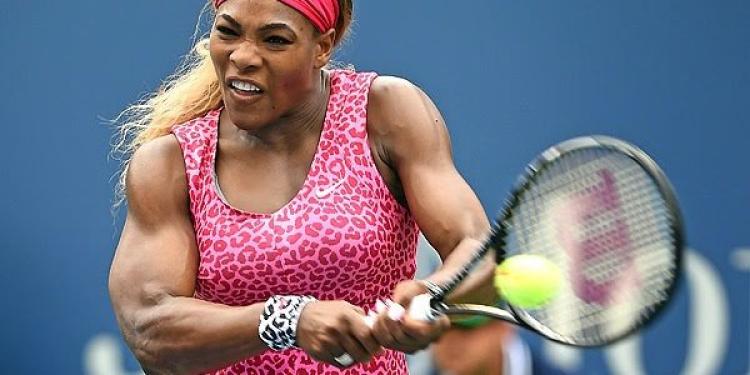Serena Williams and the Ideal Female Body Image in Tennis
Posted: July 15, 2015
Updated: October 6, 2017

Is there too much emphasis on “feminine” body type in women’s athletics?
Serena has won six grand slam titles over the age of 30. Many experts consider her at the top of her game currently. She is on pace to beat Steffi Graf’s record of 22 grand slam titles and Margaret Courts record of 24 grand slam titles. Having won her 21st grand slam at Wimbledon last Saturday, Serena has held all four grand slam titles in a single year for the second time. Despite all of this, Williams is most noted for her muscular physique that has been the subject of scrutiny in US gambling news.
• Many women’s players have avoided more intense weight training
• Serena is unprecedented affront to our notions of the beautiful female athlete
• A poll last year said 44% of women 18 to 40 were unhappy with their bodies”
Body image issues among female players tend to be a hot topic every time Williams wins a grand slam title. As a result, many women’s players have avoided more intense weight training. Tomasz Wiktorowski, the coach of Agnieszka Radwanska, spoke of his player’s body. “It’s our decision to keep her as the smallest player in the top 10 because, first of all she’s a woman, and she wants to be a woman.” As a result, Radwanska, at 5 foot 8 and 123 pounds is the smallest player in the women’s top 10.
Understanding the criticism behind body image

The New York Times just published an article that suggested that other female athletes don’t want to look like Williams because her body doesn’t fit into society’s expectation for female beauty. The Times wrote that Williams “has large biceps and a mold-breaking muscular frame” and “her rivals could try to emulate her physique, but most of them choose not to.”
Even William’s media created rival Maria Sharapova was describe in the Times article as “slender, blond Russian” and quoted her as saying “I always want to be skinnier with less cellulite; I think that’s every girl’s wish.” These comments serve two purposes. First they try to negatively portray man’s idea of physical beauty in female athletes as slender less powerful beings who are more entertaining to look at. Secondly, they re-establish old stereotypes as view female athleticism as “not as serious” as their male counterparts.
Whether it’s realized or not by those who publish these articles, many of articles that critique Serena’s size tend to have deeper roots in sexism as well as racism. If you look back to the eighties and the comments made by Jimmy “the Greek” Snyder about the breeding of black male athletes deriving from slavery in the U.S., there still remains a connection between black athletic performance and physical size. Worse, of course are the comments that don’t make gambling news.
Tomas Rios, writer for the Daily Beast wrote “because Serena Williams is a wildly successful black woman in a white-dominated sport, she occupies a fraught space within the sport itself and the society actively informing our perceptions. She is an unprecedented affront to our collective notion of the beautiful female athlete.” Many women have felt been insulted by such attempts by the media to “shape” their opinions. As a result, the Times article received a backlash of disapproving feedback.
How Serena and others have dealt with body image

Unfortunately, not enough people are aware of Serena’s own personal struggles with her body image. She recently commented on the Home Shopping Network about having to go outside in sleeves. “My arms are really fit, but I wanted to cover them, because when I do people don’t recognize me as much.” Serena herself adds to her own victimization by having the same ideas about the archetype of beauty and athleticism that is often written about her whenever she appears dominant in her sport.
“I don’t touch a weight, because I’m already super fit and super cut, and if I even look at weights, I get bigger. For years I’ve only done There-Bands and things like that, because that’s the kind of how I felt.” Serena is not alone in her opinion of herself. Andrea Petkovic, a Slavic-born player who routinely makes German gambling news, revealed a similar opinion. “Women, when we grow up we’ve been judged more, our physicality is judged more, and it makes us self-conscious.”
Petkovic also went on to speak about the surprise she receives from fans when they see her. “People say ‘oh you’re so skinny, I always thought you were huge.’ And then I feel like there are 80 million people in Germany who think I’m a bodybuilder. Then they see me in person, they think I’m okay.” Timea Bacsinszky has worked with a psychologist in order to achieve a more healthy perspective about her body and has achieved some level of acceptance. “If I know it’s for the good of my sport, then I will do it.”
A survey by Glamour Magazine last year revealed that 44% of women ages 18 to 40 “felt unhappy about their bodies” and social media was seen as the main instigator for these feelings. On average women are more negatively affected by pictures of non-celebrities. Williams, still seen as a symbol of beauty among many women, said “I’m really happy with my body type, and I’m really proud of it. Obviously it works out for me. I talk about it all the time, how it was uncomfortable for someone like me to be in my body.”











